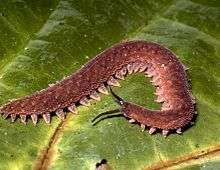Typhloperipatus
Typhloperipatus is a genus of velvet worm of the Peripatidae family, containing the sole species Typhloperipatus williamsoni.[1]
| Typhloperipatus | |
|---|---|
 | |
| Scientific classification | |
| Kingdom: | |
| Phylum: | |
| Class: | |
| Order: | |
| Family: | |
| Genus: | Typhloperipatus |
| Species: | T. williamsoni |
| Binomial name | |
| Typhloperipatus williamsoni Kemp, 1913 | |
Discovery
The species name was after Noel Williamson, a political officer at Sadiya who was murdered in 1911. The murder led to an expedition in the Abor region by the British government in India. Stanley Wells Kemp, then an assistant superintendent at the Indian Museum at Calcutta was a zoologist attached to this expedition. The first specimen was found near the gorge of the Dihang River near Rotung. Although the nearest known velvet worm species, from Malaya, are typically found in dead wood, these were found mainly under large stones near the roots of trees.[2] It is the only South Asian species in the phylum.
Description
These velvet worms have no eyes. The colour of the upperside is a deep umber brown with the tips of the antennae slightly paler brown. The papillae on the skin have pale tips and the underside is pale brown. Some individuals have a dark dorsal stripe. It has 19 to 20 pairs of oncopods, the inner jaw has a serrate edge. The oncopods have coxal glands, four complete and spiny pads and the feet have two papillae.[2][3]
Although Kemp believed that the species was closer to neotropical forms than to Southeast Asian forms, modern studies place them close to Eoperipatus of Southeast Asia.[4]
References
- Oliveira, I.; Hering, L. & Mayer, G. "Updated Onychophora checklist". Onychophora Website. Retrieved 24 November 2016.
- Kemp, Stanley (1914). "Onychophora. Zoological results of the Abor expedition, 1911-1912". Records of the Indian Museum. 8: 471–492.
- Kemp, Stanley (1913). "Preliminary note on a new genus of Onychophora from the N. E. Frontier of India". Records of the Indian Museum. 9: 241–242.
- Monge-Najera, Julian (1995). "Phylogeny, biogeography and reproductive trends in the Onychophora" (PDF). Zoological Journal of the Linnean Society. 114: 21–60. doi:10.1111/j.1096-3642.1995.tb00111.x.